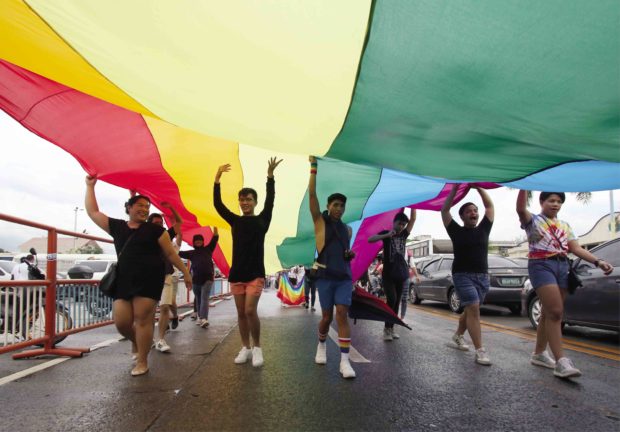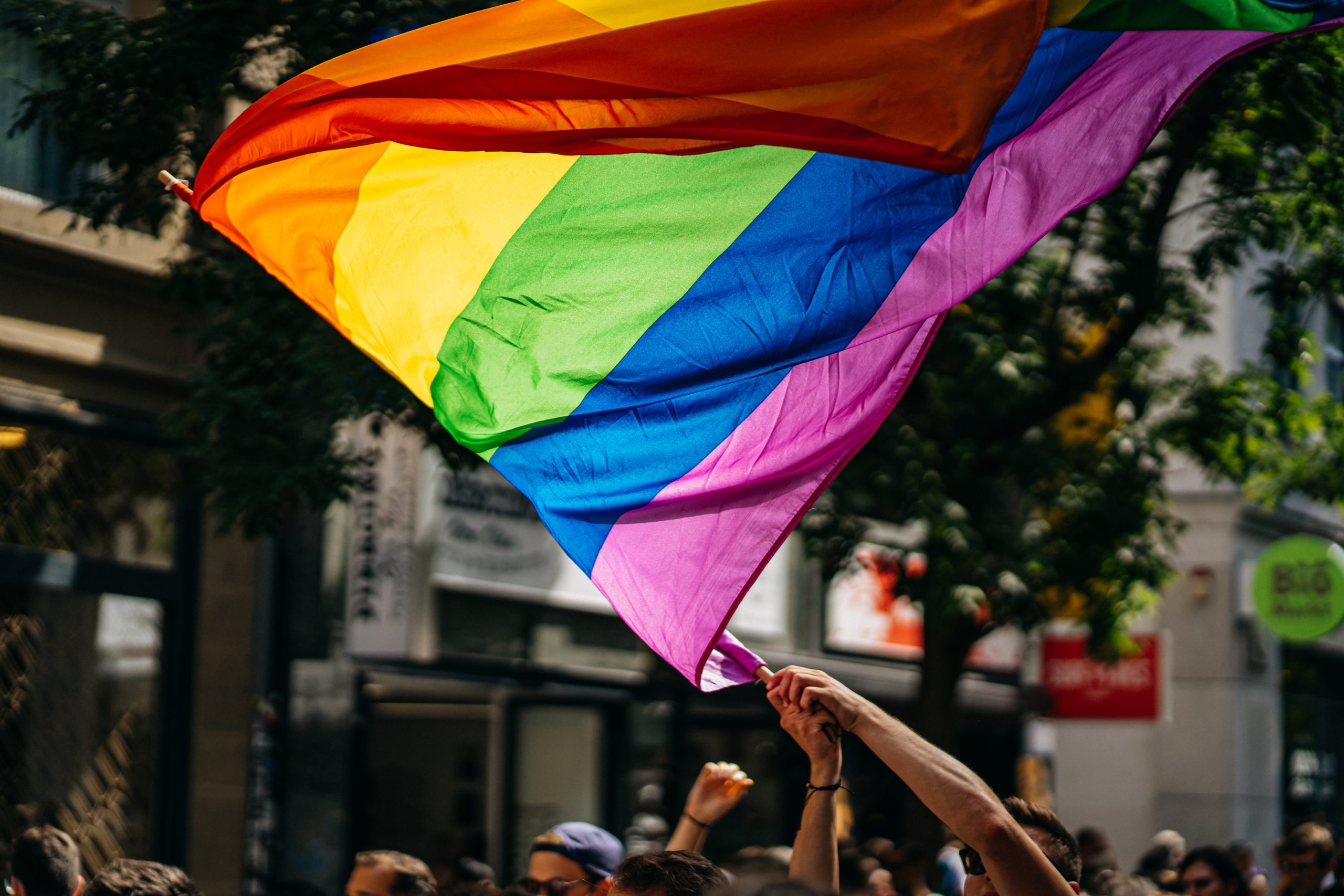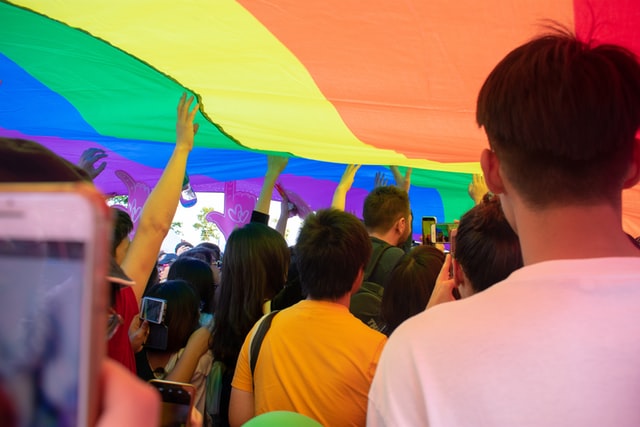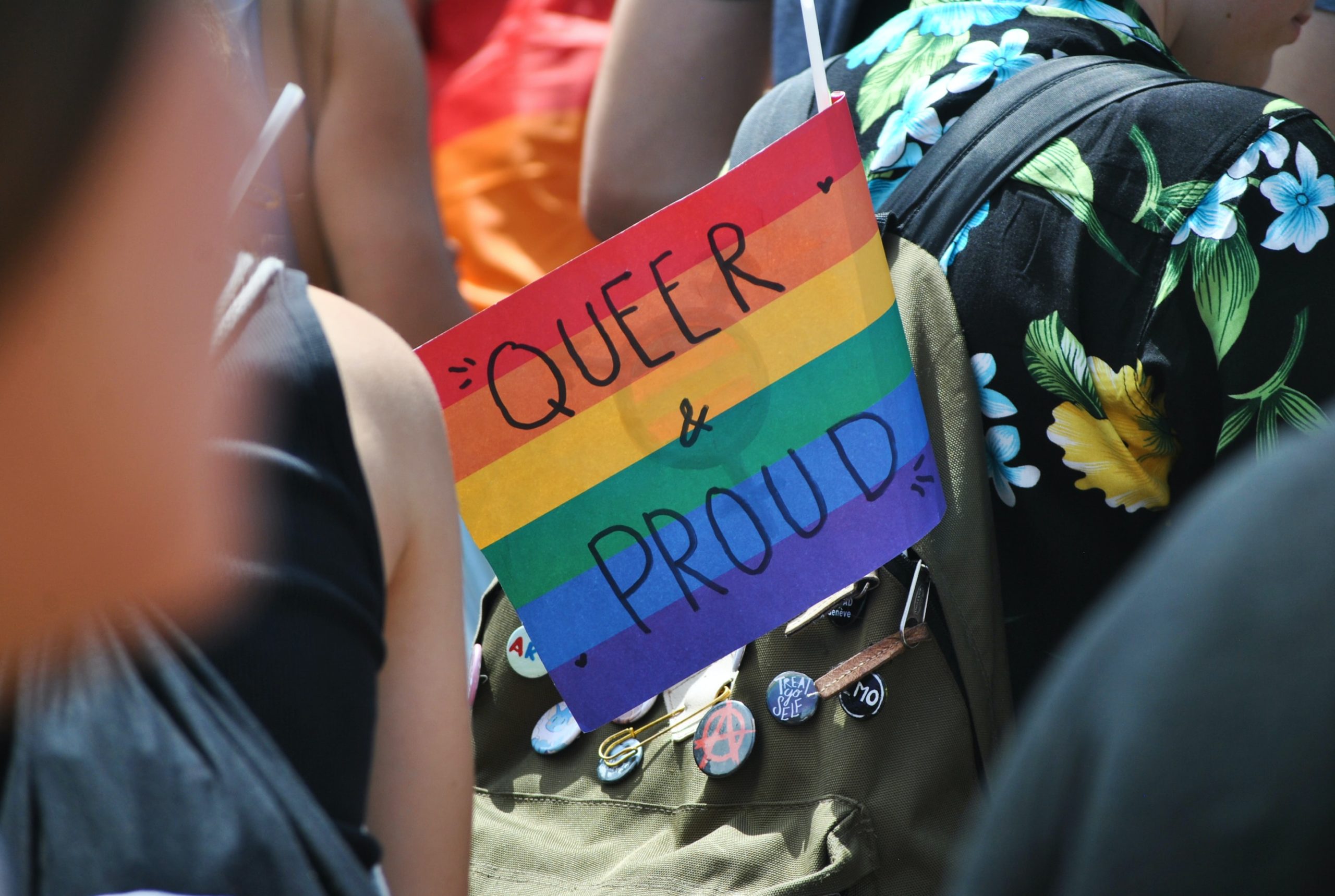Being gay in PH: Living life to the fullest

FILE PHOTO
MANILA, Philippines—For many Filipinos, especially members of the LGBTQIA+ (Lesbian, Gay, Bisexual, Trans, Queer, Intersex, Asexual) community and its allies, June is known as Pride Month—a colorful month where people celebrate the long history and milestones of LGBTQIA+ visibility in the country.
Perhaps one of the key events during Pride Month in the Philippines is the Pride March which, in previous years prior to the pandemic, has gathered tens of thousands of LGBTQIA+ members and allies.
For many, Pride Month and Pride March are also not just a celebration of the LGBTQIA+ community. It is also a form of protest, a means of speaking out on the concerns of the community—especially in fighting for the rights of every member of the community, most of whom still experience discrimination and oppression because of their gender or sexual orientation.
“As a public demonstration and expression of joy, the event is both a celebration and a mass protest,” said Metro Manila Pride, a volunteer-managed, non-partisan, not-for-profit organization in the Philippines.
“Each year, we honor the Filipino LGBTQIA+ community by creating a space that uplifts and emboldens us to gather together to challenge Philippine institutions by calling for radical change,” the organization added.
“Each year we bring together individuals, organizations, and communities to call not only for equality, but for justice for the LGBTQIA+ community in the Philippines,” it continued.
The group, which organizes or oversees the annual Pride March and Festival, said that the yearly event aims to “strengthen a sense of belonging and solidarity” among LGBTQIA+ individuals in the country.

A member of the LGBTQ+ community in Stuttgart, Deutschland waves a rainbow flag. Photo courtesy of Raphael Renter via Unsplash.
Ahead of the Pride Month, in this article, INQUIRER.net talked with some members of the LGBTQIA+ community and asked them to share their thoughts on what is it like to be a member of the community in the Philippines nowadays.
They also shared more stories about the history of the community where they belong, the significance of Pride Month in their lives, the struggles still experienced by many of them, and how they try to live through it.
More opportunities for LGBTQIA+ individuals
When asked, “What is it like to be a part of the LGBTQIA+ community in the Philippines nowadays?,” Lhouric Medina—who identifies himself as a gay person—said more opportunities have opened up for members of the communities now compared to how it was years ago.
Before, according to Medina, members of the LGBTQIA+ including “crossdressers”—persons who like to wear clothing and accessories associated with the opposite sex—were given limited opportunities when applying for a job.
This was despite the fact that most, if not all, members of the LGBTQIA+ community excel and progress in their jobs or careers.
“The members of the LGBTQIA+ are usually called the ‘color of the corporate’ or ‘color of the company.’ From the highest profession of medicine down to the colorful world of cosmetology, members of the LGBTQIA+ community excel,” Medina told INQUIRER.net in an interview.

Photo courtesy of Unsplash
Years, or perhaps decades ago, there was also a popular notion among some people which associates members of the LGBTQIA+ community with a stereotypical career or job position as parloristas or hairdressers.
“That Philippine gay culture exists is an insight not very difficult to arrive at. In our country, gays may be found virtually everywhere, and what’s strange is they have a distinct quality about them which is sometimes unnerving, sometimes welcome if only that it’s funny,” said J. Neil Garcia, professor and author of many literary works including the book “Ladlad: An Anthology of Philippine Gay Writing,” in the introduction page of his other work titled “Philippine Gay Culture: Binabae to Bakla, Silahis to MSM.
“They also have their ‘haunts,’ or places in which they gather—in loud and flaming clusters inside malls, on campuses, and in the beauty parlors which are their privileged locales because they invariably work there,” Garcia said.
However, as the country becomes more open and accepting to members of the community, more opportunities have opened up for LGBTQIA+ individuals which have set their image free from the usual parlorista trope—not that there is something wrong with working in a parlor or beauty salon.
“Before, there are many opportunities that are not given to members of the LGBTQIA+ community because people think that a gay’s place is only at beauty parlors, and that gays are just dressmakers,” Medina said.

A rainbow flag that says “Queer & Proud” by a member of the LGBTQ+ community during the Pride parade in Geneva, Switzerland held in July 2019. Photo courtesy of Delia Giandeini via Unsplash.
“More opportunities have opened for people like us. When more opportunities were made available for the LGBTQIA+, we excelled,” he added.
Louder and proud
Aside from having more opportunities or career choices, one thing that Medina used to describe what is it like to be a part of the LGBTQIA+ community in the country nowadays is that they are more loud and proud of who they are.
“Compared before, gays or members of the LGBTQIA+ are louder nowadays, in terms of showing that they can do more, that they are not limited,” he said.
Medina also said he believes that discrimination among LGBTQIA+ individuals is now “very limited.”
“That is not felt strongly nowadays. There are some cases, maybe in a hundred percent, there is like 20 percent discrimination that we still feel. But when we go out of the house, we can see that people are embracing gays, LGBTQIA+ people,” Medina said.
“Before, when you go to the mall, people are staring at [us] the way [as if] they are judging [us],” he added.
They felt more open, safer—but…
Arshi, a trans-woman, said that compared to before, members of the LGBTQIA+ are now more open and out.
“Compared to way back then, the LGBTQIA+ people are now more open and out and there are a lot of safe spaces for the community and some adjust for us,” she told INQUIRER.net in a message.
Don Moya said that for him, being a gay person felt safer now compared to before. He said he believes that social media influences more people outside the LGBTQIA+ community to be more open and understanding.
“It is now much safer compared before during early high school days and below. I guess thanks to social media, people are taught to be more open about the community,” he said in a message to INQUIRER.net.
However, Arshi and Moya said the changes in how the public perceives members of their community—specifically in the Philippines—were still not completely positive.
“Here in the Philippines, it’s not easy to accept the LGBTQIA+ community as a whole because there are still close-minded people since we are known for being a religious country,” said Arshi.
“Of course, homophobia is still rampant in the country, seeing how a lot of people still use LGBT slurs as an insult and seeing a lot of old people who are still very close-minded about the topic,” Moya said.
“Sure, I believe it is indeed safer compared to before, but it’s still not safe enough for everyone. I mean, there are still families who hurt or commit violence against their gay children, right?” Moya added.
The Fuller Project—a global nonprofit newsroom dedicated to groundbreaking reports on women—said in an article published in January 2021 that around 50 transgender or gender nonbinary individuals across the Philippines have been murdered since 2010.
“[B]ut the real death toll is likely much higher,” the article stated.
A few months later, in September of that same year, Amnesty International published a report on its website on the rampant hate crimes experienced by LGBTQI+individuals in the Bangsamoro Autonomous Region in Muslim Mindanao (BARMM).
“LGBTQI+ people in the Bangsamoro Autonomous Region in Muslim Mindanao (BARMM) face pervasive discrimination, live in the constant fear of harassment, arbitrary arrest, and detention, and remain vulnerable to violence and persecution based on their sexual orientation, gender identity, and expression and sex characteristics (SOGIESC),” the report read.
In the report, Rocky Rinabor, Amnesty International Philippines Board Member and Deputy Executive Director of the Pioneer Filipino Transgender Men Movement (PFTM), said authorities in the region often turn a blind eye on the attacks against the LGBTQI+ community—a regular occurrence in the area.
“Various attacks of hate crimes and gender-based violence directed towards Muslim LGBTQI+ people in the Bangsamoro region are not new nor isolated. It is an endless cycle where queer folks, like me, are trapped, always looking over our shoulders or sleeping with one eye open,” said Rinabor.
“We are used to being caught in the middle of unlawful raids, as if they were witch hunts, in places where the LGBTQI+ are often seen – in karaoke bars, or salons and other establishments managed by trans women, often to instill fear by setting these places on fire or drive-by shootings,” Rinabor added.
“It is also common to hear stories of Muslim lesbians subjected to ‘curative rape’ in order to ‘correct’ or ‘save’ them from homosexual relationships considered to be sinful or taboo in the Muslim culture.”
According to Rinabor, these attacks continued to traumatize members of the LGBTQI+ community in the BARMM due to a lack of accountability by authorities.
“What makes it more difficult is the fact that majority of hate crimes, if not all, are not properly investigated by local authorities. It is often dealt with impunity, based on the belief that crimes directed towards queer people are justified because it is the life we choose, thus, we must accept it and just live with the consequences it brings.”
READ: Hate crimes against LGBTQI+ in BARMM must not go unpunished
Being gay, trans in the gaming world
As casual and competitive players of online games, Arshi and Moya are part of the e-sports industry—which has been known to be a heavily male-dominated industry.
However, being a gamer and at the same time, a member of the LGBTQIA+ community has proven to be difficult for them before due to discrimination—especially when the industry was still less accommodating toward the LGBTQIA+ community.
“At the time, I was actually still closeted and kept it as a secret for almost everyone, and because of that, I didn’t get to experience it much personally but definitely the homophobia before in the gaming community was the same as it was everywhere where LGBTQ+ people were viewed as disgusting and low,” said Moya.
Arshi said that she used to get homophobic slurs and messages from “typical misogynist type” players who told him things such as “salot [ka] sa lipunan, wag ka na mag laro, and stereotyping us [by commenting] ‘150’ [or] ‘hala sabi ko na barbie’ and many more.”
According to Arshi, an example would be Johnmar “OhMyV33nus” Villaluna, a Filipino e-sports player who currently plays for Blacklist International’s team for Mobile Legends: Bang Bang.
Despite leading his team to victory in many tournaments, the veteran mid laner—addressed as “Queen” by fans—remained a target of homophobic comments online.
“Maybe my best example is OhMyV33nus. Because of his popularity here in the Philippines due to his skill as a gamer, he is prone to be a target of discrimination in the gaming community,” said Arshi.
As more LGBTQIA+ players get recognized in the industry—and for their contribution and effort in breaking gender stereotypes in the e-sports industry—the LGBTQIA+ community in the industry started to gain better representation.
READ: 5 LGBTQ Pro Esports Players Breaking Through the Rainbow Glass Ceiling
As Arshi explained, the industry is “on [its] way” to becoming more open toward LGBTQI+ gamers like her and Moya.
“I can say that it’s still on the way, it’s not yet fully opened. There are some tournaments that are exclusive for gays. What about the transgenders, mostly transwomen?,” Arshi said.
“We identify ourselves as women but when there was one time when a trans joined an all-girls tournament, many people discriminated against that person. What more in big events, right?”
Moya shared the same sentiments, adding that there are still “bits of homophobia here and there.”
Discrimination and hate words are also still being thrown at gamers like them from time to time.
“In my own experience, I don’t have anyone who blatantly discriminates me in the gaming communities that I’m in as they are pretty open-minded about the community, although it’s a different story in-game,” said Moya.
“I’m pretty sure almost everyone who’s part of the LGBTQ+ community and plays games, including me, experiences discrimination a lot in-game where people say homophobic slurs to ‘trash talk’ most of the time,” he added.
Responding to discrimination
When it comes to reacting or responding to discrimination—including hateful words and homophobic slurs and comments—Moya said he just usually ignores it.
The same goes with Arshi, who said she chooses to be more understanding and be the better person.
“Not that I am being a coward, but for me, it is better to be the one who is more understanding because it’s burdensome to explain to close-minded people,” said Arshi.
Medina echoed the same thoughts as Arshi and Moya.
“I don’t mind the comments, but I try to see what kind of person said those things to me. There are more educated people who understand us than those who judge us. I try to see what type of person they are and decide how I will react,” said Medina.
“Personally, homophobic slurs and hateful words no longer have an impact because I no longer get affected by those. Maybe I’ll analyze the way the jokes, and comments were thrown at me. There are some comments for the likes of us that are okay, but there are some that are actually hurtful,” Medina added.
A choice or not a choice
When you look up the book “Ladlad: An Anthology of Philippine Gay Writing”—which was edited by Garcia and Filipino writer Danton Remoto—online e-book stores usually use these statements as a descriptor of what the book is all about:
“Being gay is not a choice. It is really detrimental for someone living in a third-world country.”
“How do gays cope up with society’s constraints? How do they live their lives to the fullest?”
When asked whether they agree with the first statement, Moya, Arshi, and Medina shared contrasting responses and thoughts.
Arshi gave a short but straightforward reply, saying that she agrees with the statement.
Moya, on the other hand, replied: “Being gay is DEFINITELY not a choice. I mean if I had a ‘choice’ to become straight I definitely would [choose] that instead of being discriminated by the world [right?]”
“Also, living as a gay person in a third world country is certainly difficult and affects many things especially the mental health of the LGBTQ+ community as not everyone has the privilege of acquiring proper education to understand the stuff about genders and sexual orientations which results [in] the people having a disgusted outlook towards the community.”
Medina—unlike Arshi and Moya—said he disagrees and that “being gay is a choice yet a matter of chance—a chance for an individual to express his [or] her [true] self.”
He also explained that the hardships of being in a third-world country should not be a reason for an individual to choose whether to be part of the LGBTQIA+ community.
But, all three of them agreed on the same thing—LGBTQIA+ individuals, no matter what kind of struggles and hardships they face, will choose to live their life to the fullest.
For Arshi, living her life to the fullest as a trans-woman means getting the support she needs from sisterhood and safe spaces in the LGBTQIA+ community.
“It is such a big help to have a sisterhood and safe spaces within the community since we know we share the same pain we experience and we help each other,” Arshi said.
Moya said every individual in the community has different ways on how to cope with society’s constraints.
“Different gay people have different coping mechanisms. But one thing that I do and many other gay people do I think, is to use humor as a coping mechanism in order to make light of the slurs and discrimination that we hear in our lives,” he said.
“We are able to live our lives to the fullest by fully accepting and loving ourselves, along with surrounding ourselves with people who do the same with us so that we are able to function our best every day,” he added.
Similar to Moya, Medina said that gays are “happy people.”
“We are a large group of extraordinary people living in a society wherein we can freely share and show our talents, abilities, and achievements despite the obstacles we face as members of the LGBTQIA+ community,” Medina said.
“We live our [lives] to the fullest with respect to each and everyone,” Medina added.